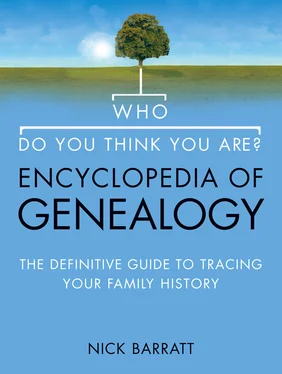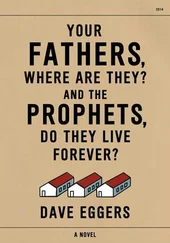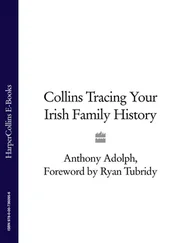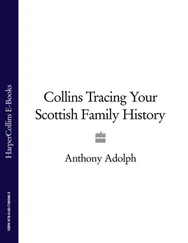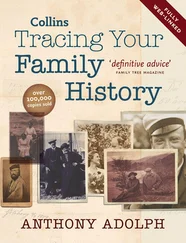1 ...7 8 9 11 12 13 ...38 He d . 1722 leaving issue:
Katherine Sherwood b . 1702
Grace Sherwood b . 1705
Emily Sherwood
Sarah Sherwood b . 1645.
Faye Sherwood unm .
This pedigree explains that James Sherwood married Alice Clarke and had four children, John, George, Sarah and Faye. John married Jane Cecily but he died without children. George married Carole Vine and had three children named Simon, Joseph and Emily. These were therefore James Sherwood’s grandchildren. His grandchild Joseph Sherwood married Mary Shanks in 1699 and died in 1722 leaving two daughters, Katherine and Grace, who would have been James Sherwood’s great-grandchildren.
Irrespective of what style of family tree you eventually decide to use, it will hopefully grow too big for your original piece of paper, so you will probably need to break the tree into sections to make it more manageable. While it is nice to have your entire family tree on one piece of paper, you should be constantly referring to it to help organize your research, and for this reason it usually makes more sense to break it down into smaller branches, perhaps with your paternal side on one tree and maternal side on another. Some people find that smaller trees of individual generations are useful for taking to archives. These can then be updated regularly and annotated while you are in the archives, and the new information transferred to your master family tree at a convenient time.
Abbreviations in Family Trees
Here are some examples of words and abbreviations used specifically in family trees:
b.born
m. or mar.married = married
2.second marriage
d.died
ob.or obit.died
d.s.p.or o.s.p.died childless
d.v.p.or o.v.p.died before father
1.left descendants
bapt.or bp.baptized
chr.christened
bur.buried
lic.licence (marriage licence)
MImonumental inscription
c.circa or about
?uncertain or unknown
o.t.p.of this parish
w.wife
s.son
s. and h.son and heir
dau.daughter
g.f.grandfather
g.m.grandmother
g.g.f.great-grandfather
g.g.m.great-grandmother
inf.infant
spin.spinster (unmarried woman)
bach.bachelor (unmarried man)
unm.unmarried
div.divorced
wid.widow (a woman whose husband has died)
wdr.widower (a man whose wife has died)
mat.maternal or female side of the family
pat.paternal or male side of the family
Distafffemale side of the family
Spearmale side of the family
Online family trees and family tree software packages are extremely helpful to collate your tree in its entirety so that you can share it with other family members, and to organize the end product of your research. Using these resources saves you the effort of constantly rewriting a large family tree if you run out of space or make mistakes, because you can easily log onto your electronic tree and edit the details as needed. Most genealogy software now saves your family tree and genealogical data as a GEDCOM file, which stands for Genealogical Data Communications. This has been created to make sharing your tree easier, regardless of the software you use.
The important components of a comprehensive family tree are:
• Names, including Christian or forename, surname, maiden name and any nicknames
• Dates of birth, marriage and death
• Place of birth, marriage, death and abode
• Occupation
You can buy computer software packages to upload onto your PC, such as Family Tree Maker, Roots Magic, Family Tree Builder and Family Historian – all are popular and very flexible in how you can organize your data. They will come with instructions on how to print out your tree once you have uploaded it using the software, and most software now shows you how to build your own family history website using one of their website templates. Alternatively, there are many free family tree tools available from genealogy websites, which just require you to register your details on their website to create an account, after which you can share your tree with other enthusiasts online. Most of these also give you the option of keeping most of the details on your tree private or only accessible by users who ask for permission to view your tree first.
The four sample websites described below will be looked at in more detail in Chapter 4in the context of the sets of data and documents they offer, but their family tree building tools and software are examined here.
Genes Reunited is a sister site of Friends Reunited and works as a database of family trees, enabling people to find others who are looking for the same ancestors. Other users will not see your full family tree unless you grant them permission after they have emailed a request to view it. You can search the Genes Reunited database of names, years and places of birth to see if any match the people in your tree. To make contact with other researchers you need to upgrade to a full membership for a small fee. When uploading your family tree, each person you add has a fact sheet to complete, listing their names, dates and places of birth, marriage and death, occupation, any notes, and a photo. You can view your family tree in a drop-line format showing all your relatives, just your ancestors or descendants, or your immediate family. It is possible to search the database’s collection of historical records and merge these into your tree, and the software will automatically use these to create a lifeline for each person showing the key events of their life. Genes Reunited also has a special print function for printing out your family tree diagram.
Ancestry is an online genealogy company that provides, along with many millions of records, access to family tree building software and the facility to upload it onto their website. They have created a free online template that can be accessed by clicking the ‘My Ancestry’ link along the top of the homepage. The Ancestry family tree facility creates a homepage for each person on your tree, where you can enter their dates of birth and death, their spouse’s details and children’s names, upload photos, write a biographical story, and add events to a timeline. A summary of the information you enter is displayed on a family tree showing the direct line, working from left to right. Ancestry has a search facility that checks the details you enter against its collection of historical records and other users’ family trees to see if there are any matches. This can help you get into contact with other people who may be researching part of your tree (which is usually because you are related somewhere along the line). You can change the privacy settings for your tree so that it can only be viewed by those people you email it to, otherwise the default setting puts your tree in the public domain so that other Ancestry users can find the information it contains.
Читать дальше
